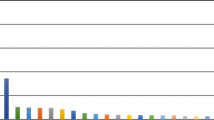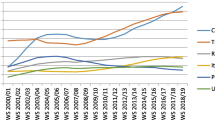Abstract
This study describes visual analysis to understand and comprehend the strategies in local governments. The Japanese government established Headquarters for Overcoming Population Decline and Vitalizing Local Economy to solve population and economic decline. On the basis of the comprehensive strategy from the headquarters, each local government also formulates original strategies. This study analyzes two networks, namely, word and government networks, generated by their strategic statements. By analyzing these networks, we understand that each local government adopts a similar strategy based on marriage, emigration, health, medical care, and so on.
You have full access to this open access chapter, Download conference paper PDF
Similar content being viewed by others
Keywords
1 Introduction
The Japanese population tends to decrease after the peak in 2008 [1]. The population is predicted at 97 million in 2050 and 50 million at the beginning of the 22nd century. The population concentration in Tokyo is accelerating. Tokyo area (Tokyo, Saitama, Chiba, and Kanagawa prefectures) has overturned 119,000 people for 20 consecutive years, whereas Osaka and Nagoya areas recorded over delivery for three consecutive years starting 2015. The majority of population movements to Tokyo area are young people; and 90,000 people are aged of 15–24 years. In 2015, Tokyo area had a population of 36,126,000 people, which was more than a quarter of the total population.
Rural areas are facing the problem of population decline, which results in the shrinking of the regional economies and consequently accelerates the population decline. The declining population has caused a serious manpower shortage, leading to the decline in businesses and rural areas.
The cabinet established the Headquarters for Overcoming Population Decline and Vitalizing Local Economy in Japan. The goal of the institution is for each region to create an autonomous and sustainable society that utilizes its respective features [2]. To eliminate the harmful effects of traditional policies, to overcome the population decline, and to ensure the regional creation, the headquarters launched the five principles of policy toward “creation of towns, people, and workers.”
On the basis of these five principles, the headquarters formulated the “Comprehensive Strategy for Town, People, and Creation” to overcome the population decline and a five-year plan to realize a vibrant Japanese society in the future. This strategy is a summary of the five-year targets and the basic direction and details of policies from FY 2015. The local governments also formulated their own comprehensive strategies based on this comprehensive strategy.
The unique comprehensive strategies have the same tendency because they are based on the “Comprehensive Strategy for Town, People, and Creation”. However, each local government environment is different, and strategies are also different and specialized for each government. For example, the population vision and strategy of each district in the 23 districts of Tokyo are similar, but the strategy differs between the 23 districts and the local governments. Implementing the PDCA (Plan, Do, Check, Action) cycle is also mandatory in executing this strategy so that local governments should evaluate the results obtained from their strategies and plan new strategies for improvement.
When a local government is successful, the possibility that another government succeeds equally increases by sharing ideas. A successful local government becomes a role model for other local governments, and the possibility of the success of the strategy increases. However, the reference relationships, that is, similarities among the strategies, are unclear. Hence, finding related governments as role models is difficult.
This study visualizes the relationships among local governments by comparing the strategies with each other. We utilize network visualization to comprehend the relationships and global causality hidden in communities. We also consider the reasons and find information from different viewpoints.
2 Analysis Process
The comprehensive strategy basically is shown in document (that is, sentences and figures). We collect the texts from the strategy statements. To find the cores and keys of strategy, we extract keywords by using TF-IDF. Based on the keywords, we generate two networks and perform clustering for analysis.
2.1 Keyword Extraction
Keyword extraction is a basic process in text mining. Morphological analysis is conducted for text data before keyword extraction. We identify parts of speech and filter the unnecessary POS set. We adopt words that belong to a verb, noun, adjective, adverb, and interjection. We remove stop words that have no meaning. We extract the keywords after preprocessing. To extract the keywords, we use the TF-IDF algorithm as follows:
where \( v_{ij} \) is the frequency of the appearance of word \( i \) in document \( j \) (\( j\, \in \,D,D \): document set), \( n_{j} \) is the sum of words in document \( j \), N is the number of documents in a document set, and \( df_{i} \) is the number of documents word \( i \) appears in.
Finally, we extract the keywords for a document set using Eq. (4):
We extract the important keywords for document sets by using Eq. (4) and ranking the keywords based on the value of TFIDFi. In this study, the top 100 words (including same-ranked words) are regarded as keywords and are utilized as nodes in the network.
2.2 Generating Networks
A network is often called a graph, which is a representation of a set of objects called nodes, where some pairs of objects are connected by links. We generate two networks using the extracted keywords. One consists of government names as nodes and tendency of keywords as links. We call this network government network for convenience. Another network consists of keywords as nodes and co-occurrence degree as links. We call this network word network for convenience. We can understand the positions of each government by analyzing the former network. We can understand key concepts and important topics by analyzing the latter network.
These links in both networks are essentially equal to similarities. We utilize cosine similarity, which is calculated using Eq. (5):
where \( \vec{A} \cdot \vec{B} \) is an inner product and \( \left| {\vec{A}} \right| \), \( \left| {\vec{B}} \right| \) is the norm of each vector that expresses node attributes.
2.3 Clustering
Clustering is a method used to understand the causality and topics hidden in the data and to summarize, classify, and separate data. Several clustering methods, also known as community detection methods, are used for graph mining. We can understand easily the positions and key concepts as described above by clustering. This study uses the method proposed by Newman [3]; the method aggregates the nodes based on modularity, which has a value close to 1. Modularity is defined as follows:
where eij is the percentage of the number of edges from cluster i to cluster j to the total edges, eii is the percentage of the number of internal edges in cluster i to the total number of edges, and ai is the percentage of the number of edges connected to cluster i to the total number of edges. The Newman method focuses on \( \Delta Q \), as shown in Eq. (7):
The process of the Newman method is as follows:
-
1.
All nodes are allocated as clusters.
-
2.
\( \Delta Q \) is calculated for all pairs of clusters.
-
3.
Two clusters with the highest \( \Delta Q \) are aggregated.
-
4.
Steps 2–4 are repeated until \( \Delta Q < 0 \).
3 Analysis
We collected texts from 1609 local governments by hand. Morphological analysis and POS tagger were performed using MeCab. The government network was generated using the top 200 keywords and the thresholds of links over 0.7. The word network was generated using 500 keywords and the thresholds of links over 0.7.
Figures 1 and 2 are the word network and the government network, respectively, visualized using Graphviz [4]. The colors in these networks except white mean cluster information. The cluster with more than five nodes is labeled manually because it can be labeled easily.
The word network looks sparse and is divided into seven clusters, namely, health, sightseeing, disaster prevention, medical care, traffic, road, welfare, and enterprise. Also, the government network is a dense network; each government takes similar strategies to others. However, after clustering, the clusters are categorized into “married, education,” “health, education,” “project, health,” “facility equipment, security,” “attraction of enterprise, emigration,” “married, emigration,” and “emigration, married, health, and medical,” which are the keywords about population increment that appear as common elements beyond several clusters. These elements attach importance to the comprehensive strategy. Promoting emigration, development of faculty equipment for marriage, education for children, and healthy living are important and basic strategies for rebuilding health.
Next, we verify these results by referring to several governments. In the emigration strategy, Kitakyushu City approaches 20–34-year-old women for city promotion to handle the needs of emigration and sightseeing and promote and generate information for women based on the known needs. Kitakyushu City also supports living fee, especially, housing fee for young people. Kitakyushu City also provides avenues to meet a new partner. For young people to desire marriage, Kitakyushu City supports the foundation and management of meeting chance providers and holds a seminar about communication skills, marriage, and birth consciousness. Higashi Yoshino Village supports the rebuilding and reform of houses and operates shared offices for immigrants [5]. This village manages a databases of single persons. The database is used to facilitate introductions between singles. Shimanto City in Kochi Prefecture invites satellite offices, call centers, and next-generation farming companies and prepares the shared offices in the same way as Higashi Yoshino Village [6]. For the health strategy, Higashi Yoshino Village provides a watching system service for elder people and supports sports. Kudo Village in Iwate Prefecture supports consultancy for special health advice and cancer diagnosis. For education, Miyoshi City in Tokushima Prefecture and surrounding cities promote education systems specialized on the area and support the travel fee for foreign cities [7].
Each local government implements similar strategies but manages their young people based on a specialized strategy in each area.
4 Conclusion
This study described network visualization to understand and comprehend the strategies of local governments. We analyzed two networks, namely, word and government networks. Results showed that the local governments adopt similar strategies but maintain their originality by using their strengths.
References
Comprehensive Strategy of Overcoming Population Decline and Vitalizing Local Economy in Japan, March 2017. http://www.kantei.go.jp/jp/singi/sousei/info/pdf/20141227siryou5.pdf
Meeting of the Council on Overcoming Population Decline and Vitalizing Local Economy in Japan, February 2017. http://japan.kantei.go.jp/96_abe/actions/201410/10article2.html
Newman, M.E.J.: Fast algorithm for detecting community structure in networks. Phys. Rev. E 69(6), 066133 (2004)
Graphviz – Graph Visualization Software, February 2017. http://www.graphviz.org/
Comprehensive strategy in Higashi Yoshino City, February 2017. http://www.city.kitakyushu.lg.jp/soumu/28500005.html
Comprehensive strategy in Shimanto City, February 2017. http://www.city.shimanto.lg.jp/gyosei/creation/doc/file02-03.pdf
Comprehensive strategy in Miyoshi City, February 2017. https://www.miyoshi.i-tokushma.jp/docs/4885.html
Acknowledgment
This work was supported by JSPS KAKENHI (grant nos. 16K01250 and 25420448).
Author information
Authors and Affiliations
Corresponding author
Editor information
Editors and Affiliations
Rights and permissions
Copyright information
© 2018 Springer International Publishing AG, part of Springer Nature
About this paper
Cite this paper
Saga, R. (2018). Visual Analysis for Overcoming Population Decline and Vitalizing Local Economy in Japan. In: Stephanidis, C. (eds) HCI International 2018 – Posters' Extended Abstracts. HCI 2018. Communications in Computer and Information Science, vol 850. Springer, Cham. https://doi.org/10.1007/978-3-319-92270-6_15
Download citation
DOI: https://doi.org/10.1007/978-3-319-92270-6_15
Published:
Publisher Name: Springer, Cham
Print ISBN: 978-3-319-92269-0
Online ISBN: 978-3-319-92270-6
eBook Packages: Computer ScienceComputer Science (R0)






